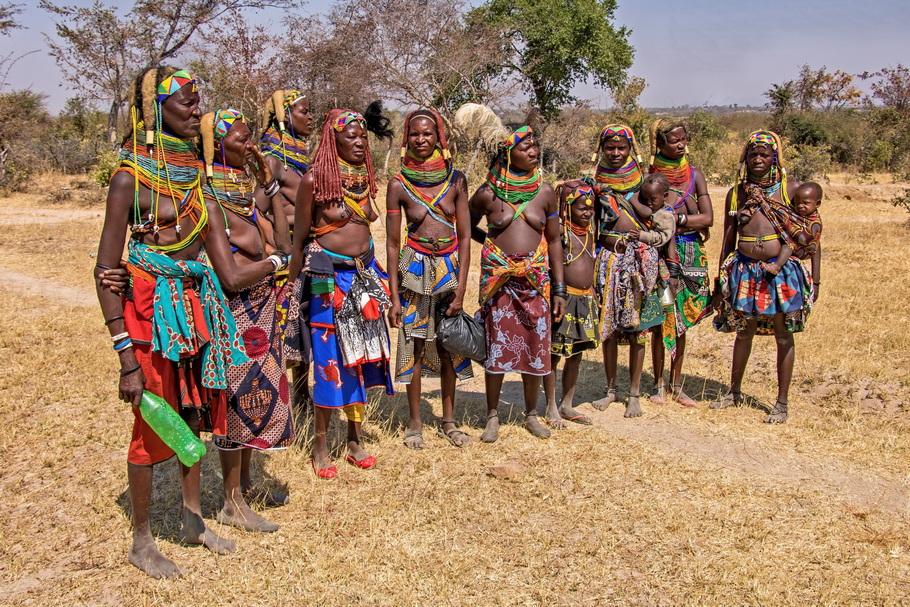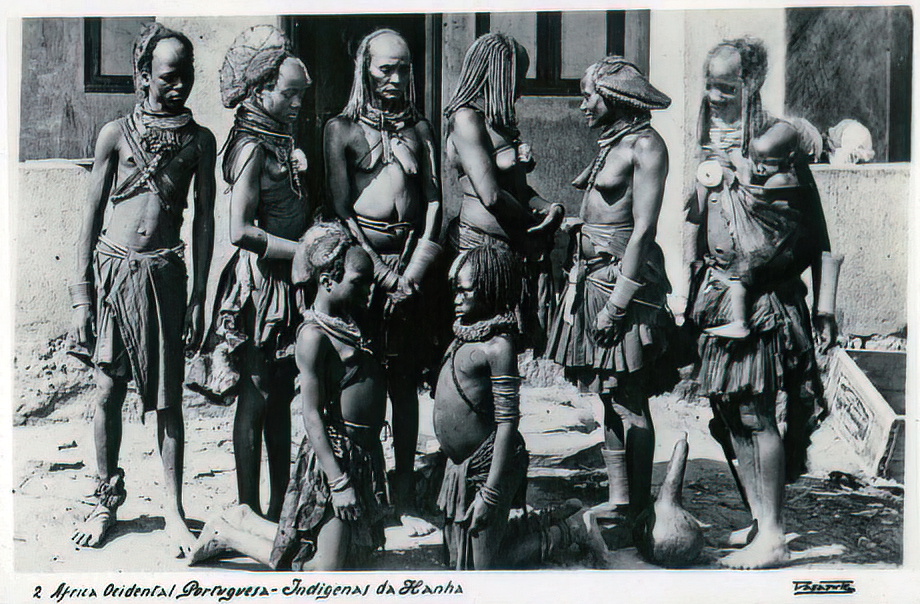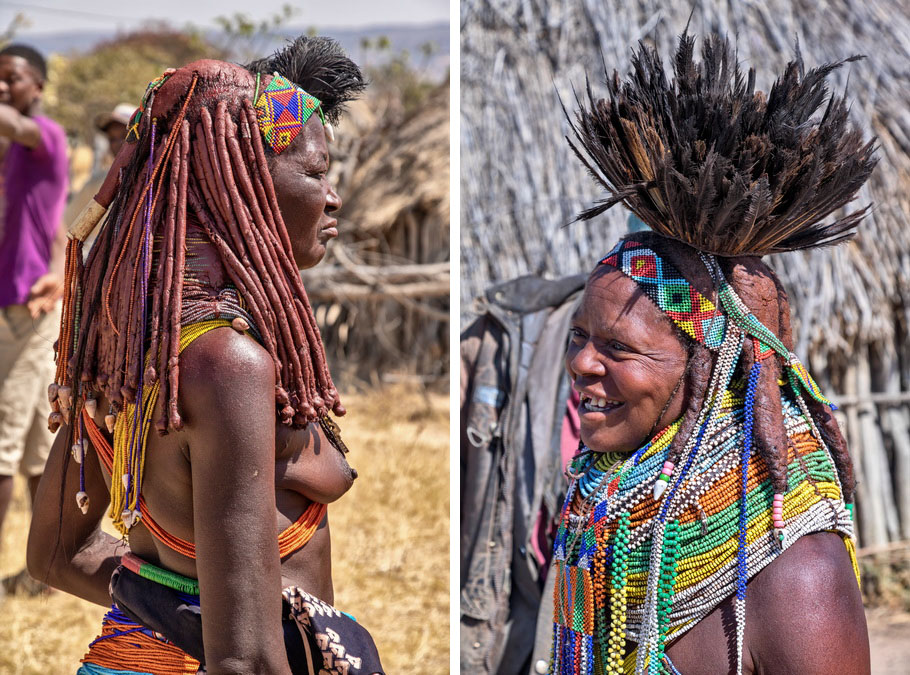

Mwila or Mwela people are a cluster of semi-nomadic ethnic group living in southern Angola, in the area of Huila.
Mwila people actually belongs to the larger Nyaneka-Khumbi (Nhaneka-Humbe) amalgamated ethnic inhabiting the Haumpata Plateau and along the headwaters of Rio Caculovar in South Western Angola in Huila Planato or Huila Province, the province that takes it name from the people.
The Mwela (Mwila) dilect speaking people of Nyaneka-Humbe (the first group is also spelled Haneca; the latter group is also spelled Nkumbi) include Mwila (which comprises Muila, Huila, and Quila and are together referred to as Mumuila by some historians and anthropologists) and lesser tribes of Jau, Humpata, and Kihita (Quinhita) as well as the Mwila-Gambwe tribes.
Mwila people are famous for keeping to their traditional African culture as exhibited in their stylish hairstyles, unique way of putting up dresses and how they specially adorn their body with ornaments (jewelleries).

100.000 Mumuila live in Huila Plateau. Last Places team of ethnographers has divided the Mumuila tribe in Plain Mumuila (East of Chibia town) and Mountain Mumuila (West of Chibia town). They speak the same Nyaneka language with slight dialect differences but women dress differently with Plain Mumuila more richly decorated (hair and necks).
Mwila people speak Mwela, a dilect of Nyaneka Bantu language which belongs to the larger Niger-Congo phylum.
Mwila dilect is spoken by about 6% of Angolan people who are mostly residing in the Haumpata Plataeu and Huila Planato of south East Angola, Huila Province. Mwila people can be found mostly in Mucuma, Chibia area, Caiend and Lubango.

Mwila people are of Bantu origin and are said to be one of the earliest Bantu people to undertake the Great Bantu migration to domicile in their present location in Angola.
According to their oral tradition, they settled down in that area during the 17th century, because of a drought that made them abandon their lands in the country of Quilengues. In fact it seems Mwila are supposed to be a miscegenation of Jaga invaders, coming from east (and who made transitory invasion in Congo) and conquered the area, with the aboriginal inhabitants of the area, the Chimbemba (or Bachimba).
The conquerors formed the powerful kingdom of Huila during the 17th century, led by a Soba, which ruled the area until the first half of the 19th century. Mwila were part of this chiefdom and most of the traditions of these Bantu cattle farmers date back to these times, although it is not clear for them nowadays.
Unlike the other ethnic groups that fled from Angola to neighbouring country, Namibia as a result of wars, drought and invasion by powerful ethnic groups, the Mwila people and their parent ethnic group Nyaneka-Humbe did not disperse outside Angola.
These people culturally remain fiercely independent, a point made clear by the continuation of their fantastic dress. The largest settlement in the region is Lubango.
It became the only city in the former Portuguese colony that had a white majority at independence, because these semi-nomadic people outright refused to live there.
In 1988 the Nyaneka-Humbe (the first group is also spelled Haneca; the latter group is also spelled Nkumbi) constituted 3 percent of the population.

Mwila people are semi-nomadic people who engage in subsistence agriculture and some form of livestock keeping. They grow mostly maize and as well as other staples. They keep animals such as fowls, goat and cattle.
The Mwila people are also noted for bee-keeping to extract honey which is major part of their diet. Mwila or Mumuhuila rarely eat meat, they rather eat porridge, corn, chicken, honey and milk. They kill their cattle only on special occasions.
Living conditions are tough as women sometimes walk for 50 kilometers to reach Huila market to sell goods. They trade their livestock and crops for mostly things like cloth, blankets, sugar, cornmeal, salt, and wine.
They have a tribal chief who serves as the head of the tribe followed by a headman. Serving under the headman are the elders. Conflicts are resolved by the elders and the headman. A diviner is also often called upon.

Mwila are not allowed to mention people’s name in public. But Mumuhuila women are especially famous for their very special hairstyles. Indeed hairstyles are very important and meaningful in Mwila culture.Women coat their hair with a red paste called, oncula, which is made of crushed red stone. They also put a mix of oil, crushed tree bark, dried cow dung and herbs on their hair. Besides they decorate their hair with beads, cauri shells (real or plastic ones) and even dried food.
Having their forehead shaved is considered as a sign of beauty. The plaits, which look like dreadlocks, are called nontombi and have a precise meaning. Women or girls usually have four or six nontombi, but when they only have three it means that someone died in their family.
Mumuhuila Women are also famous for their mud necklaces, which are important as for each period of their life corresponds a specific type of necklace. When they are young, girls wear heavy red necklaces, made with beads covered with a mix of soil and latex.
Later girls start to wear a set of yellow necklaces called, Vikeka, made of wicker covered with earth. They keep it until their wedding, which can last 4 years.
Once married they start to wear a set of stacked up bead necklaces, called Vilanda. Women never take their necklace off and have to sleep with it.
They also use headrests to protect their hairstyles. However, more and more men and women dress in a western way, because people use to make fun of them when they go to markets.
The Mwila are traditionalist who believe in a Supreme being. They also believe that the spirits of their ancestors can either work for their good or for their worst.
In order to please the ancestors animal sacrifices have to be made. At birth a child is dedicated to a spirit by his parents. This is to "bless" and "protect" him.

Plain Muila outstand among other tribes for their rich body decoration. From their childhood until their old age, Plain Muila women do not cease to add bead necklaces, seashells, and metal objects to their necks, forearms and ankles. They are efficient farmers and, although cattle are not a key element in Plain Muila economy anymore, the older generations still worship the bull god. Their culture is in constant pressure due to the increasing presence of Christian missionaries and the emigration of the youth to urban centers.
100,000 Plain Muila live east of Chibia town in the fertile and rolling plains of Huila Plateau
The Plain Muila are basically subsistence farmers and still keep some cattle. They gather in daily markets (except Sundays and Mondays) to sell and buy agricultural, artisan, and manufactured products. Some few Plain Muila women still produce fine pottery to sell in markets. The Plain Muila have a paramount chief that acts as a tribal leader or king, followed by other headmen that control the villages’ activities. Serving under the village headman are the elders. Social conflicts are solved by the elders, the local headman and a diviner
It is in basketry and metal where the Plain Muila can show their art. Large granaries and baskets to collect both the harvest and eggs or medicinal plants are still made in many villages. Pottery, once popular, has fallen in disuse and only a few families still make pots, plates and large jars from which to brew corn beer.
Although in decline, Plain Muila blacksmiths are still active, making field tools, knives, arrowheads, spears, and jewelry. Older women still know how to make sophisticated clay or wooden dolls, decorated with glass or plastic beads, metal and strings; where they represent the hairstyle of the girls of the tribe.
The vernacular architecture of the Plain muila follows the same pattern as that of their neighbors the Handa, with the difference that they do not cover the wooden structures with clay. The rectangular houses are lined around a central courtyard. In the towns closest to the cities, metal sheets have begun to replace thatched roofs.
Plain Muila women cover their hair with a red paste, called ‘oncula’, which is made from a crushed red stone. They also put a mixture of oil, crushed tree bark, dried cow dung and herbs on their hair. In addition, they decorate their hair with beads, metal objects, cowrie shells and even dry food. This practice is only observed in women over forty years old, since the younger generations only decorate their hair during initiation ceremonies. Glass and plastic bead necklaces, known as ‘missanga’, are essential aesthetic elements of Plain Muila women; each color has a different meaning and they are usually purchased as a dowry payment.
Puberty rituals and cow worship are the main religious and ceremonial displays among the Plain Muila. The animistic Plain Muila, consider that certain animals of the flock guard the souls of their ancestors. Nowadays, the annual procession that used to travel the lands of each religious chief jurisdiction to bless the ground, through the sacred bull, and attract good harvests for the coming year has fallen into disuse. There are those who see in this ceremony the remains of the ancient worship of the Egyptian god Apis.
The “cockscomb” hairstyle used during the ‘otyipwaendo’ period, prior to the ‘fico’, ceased to be used from 1975. Currently, symbolic ceremonies can still be performed, where the techniques of making this iconic hairstyle among young initiates are recovered
The Plain Muila, like all the tribes of the Huila Plateau, live under the constant pressure of the new Christian churches, forced assimilation through schooling, as well as incorporation into the system of industrial agrarian production and land theft. Last Tribes collaborates with various Plain Muila communities to preserve animist worship temples, sacred forests and supports local projects to preserve crafts and promote traditional culture among young generations.
The most iconic tribe of Angola Mountain Muila people speak the same language as the Plain Muila, but we consider them a distinct tribe because of their mountainous ecosystem and their unique aesthetics. Women wear less decoration in their hair and necks and their hairdos and dressing style are more homogeneous than that of the Plain Muila. They live in small isolated villages in thorn forests, which has enabled them to better preserve their traditional lifestyle and animistic belief system.
80,000 Mountain Muila live west of Chibia town in the forested hills of Huila Plateau.
The Mountain Muila own slightly more livestock than their relatives in the plain, but their economy currently depends on agriculture, based on the cutting and burning of thorn forest and on the manufacture of corn liquour to sell in local markets. Men make wooden headrests, canes and stools. Women come down from the mountains on market days to sell and buy agricultural, craft and manufactured products. Like the Plain Muila, the Mountain Muila are ruled by a tribal king who controls all mountain villages. In turn, each town is controlled by a hereditary chief, a group of elders and the local fortune teller.
Mountain Muila men are excellent wood craftsmen. They manufacture very beautiful headrests, canes, ‘porriños’ (sticks to govern cattle and for hand-to-hand fighting), stools and pipes.
Women make basketry to store the grain and vegetable fiber dolls that they cover with reddish clay and decorate with the characteristic hairstyles of the tribe.
Architecturally, Mountain Muila villages are the most traditional of all the Bantu groups on the Huila Plateau. The isolation of the mountains has preserved the classic style of distribution of the houses: rows of three or four houses in parallel with a central square where they meet to rest under a shed or to celebrate ceremonies. The architectural style is similar to that of the Congolese people: large rectangular wooden single spaces with a thatched roof.
For Mountain Muila women hairstyle is very important and meaningful. Having their forehead shaved is considered a sign of beauty. The dreadlocks that hang from behind are called ‘nontombi’. The number of big dreadlocks has a meaning: three dreadlocks indicates that there is a dead person in the family, while four to six dreadlocks is the normal style.
Mountain Muila women also wear impressive necklaces known as ‘missanga’. Each type of necklace corresponds to a specific period of their life. When they are young, girls wear heavy red necklaces, made with beads and covered with a mix of soil and latex. Later, girls start to wear a set of yellow necklaces called ‘vikeka’, made of wicker covered with soil. They keep them around four years, until their wedding. Once married, they start to wear a set of stacked up bead necklaces, called ‘vilanda’. Mountain Muila women never take their necklaces off and have to sleep with them. They also use wooden headrests, some beautifully carved, to protect their hairstyles.
The Mountain Muila still practice ‘Nyaneka’ Animistic religion in their mountain villages. They believe that the spirits of their ancestors can influence their lives, both for good and bad. In order to please the ancestors, they occasionally sacrifice a cow, which is a sacred animal. At birth, parents entrust the newborn to a spirit, to bless and protect it.
The Mountain Muila rely on female fortune-tellers to clear up doubts in the face of future uncertainties, mainly in relation to the rains and the harvests. From time to time, one of these women responds to the uncertainties of her community. To do this, she selects a hen and proceeds, very slowly, to pluck it, in an act of total concentration. After this, she analyzes the veins of the animal’s wings, which allows her to intuit the first responses. Later, after slaughtering the bird, she proceeds to gut it and interpret the future according to the arrangement and size of the internal organs.
Unlike their neighbors on the plain, the Mountain Muila have been able to better safeguard their independence in the depth of the mountains and valleys of the Serra da Leba. The challenges for this amazing people, iconic in Angola, are protecting their culture and their ecosystem and improving their living conditions through a growing tourism that visits their territory attracted by traditional tribes.
Sources: